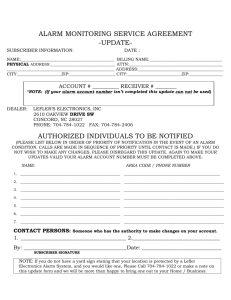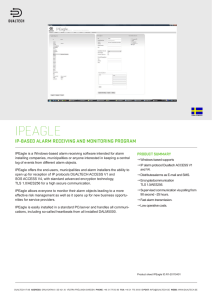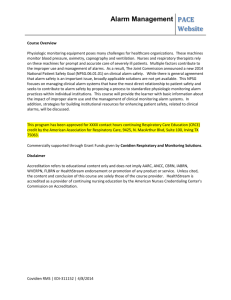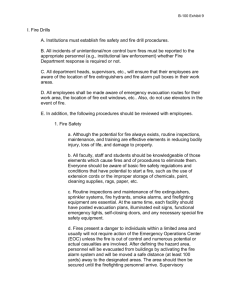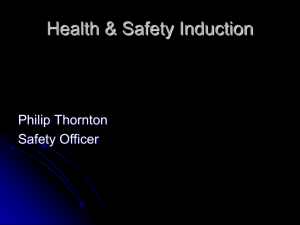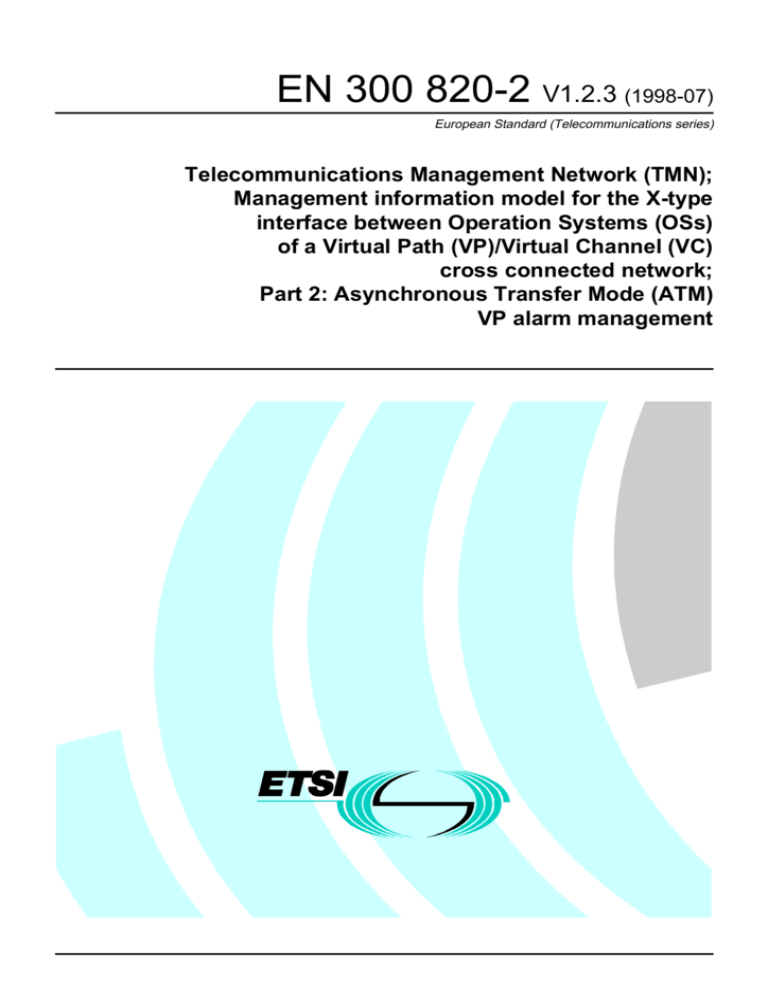
EN 300 820-2 V1.2.3 (1998-07)
European Standard (Telecommunications series)
Telecommunications Management Network (TMN);
Management information model for the X-type
interface between Operation Systems (OSs)
of a Virtual Path (VP)/Virtual Channel (VC)
cross connected network;
Part 2: Asynchronous Transfer Mode (ATM)
VP alarm management
2
EN 300 820-2 V1.2.3 (1998-07)
Reference
DEN/TMN-00032 (7lci0iq0.PDF)
Keywords
B-ISDN, broadband, ISDN, management
ETSI
Postal address
F-06921 Sophia Antipolis Cedex - FRANCE
Office address
650 Route des Lucioles - Sophia Antipolis
Valbonne - FRANCE
Tel.: +33 4 92 94 42 00 Fax: +33 4 93 65 47 16
Siret N° 348 623 562 00017 - NAF 742 C
Association à but non lucratif enregistrée à la
Sous-Préfecture de Grasse (06) N° 7803/88
Internet
secretariat@etsi.fr
http://www.etsi.fr
http://www.etsi.org
Copyright Notification
No part may be reproduced except as authorized by written permission.
The copyright and the foregoing restriction extend to reproduction in all media.
© European Telecommunications Standards Institute 1998.
All rights reserved.
ETSI
3
EN 300 820-2 V1.2.3 (1998-07)
Contents
Intellectual Property Rights................................................................................................................................4
Foreword ............................................................................................................................................................4
1
Scope........................................................................................................................................................5
2
Normative references ...............................................................................................................................5
3
Definitions and abbreviations ..................................................................................................................6
3.1
3.2
Definitions ......................................................................................................................................................... 6
Abbreviations..................................................................................................................................................... 8
4
Requirements ...........................................................................................................................................8
5
Resources for ATM VP alarm management ............................................................................................9
5.1
5.2
6
6.1
6.2
6.3
6.4
7
7.1
7.2
7.3
The basis for the exchange of management information.................................................................................... 9
The managed resources.................................................................................................................................... 10
The VP alarm reporting management function sets...............................................................................10
VP alarm reporting MS - Overview ................................................................................................................. 10
Alarm notification MFS ................................................................................................................................... 11
Alarm processing MFS .................................................................................................................................... 12
Alarm event logging MFS................................................................................................................................ 12
Management functions...........................................................................................................................13
Alarm notification management functions ....................................................................................................... 13
Alarm processing management function .......................................................................................................... 18
Alarm event logging management function ..................................................................................................... 18
8
Scenarios ................................................................................................................................................19
9
Management information .......................................................................................................................20
9.1
9.1.1
9.1.2
9.1.3
9.2
9.3
Relationships.................................................................................................................................................... 20
Managed objects ........................................................................................................................................ 21
Inheritance tree........................................................................................................................................... 22
Naming tree................................................................................................................................................ 22
X-interface GDMO description ....................................................................................................................... 23
X-interface ATM VP alarm management ASN.1 module................................................................................ 23
Annex A (informative):
Security aspects..............................................................................................24
History ..............................................................................................................................................................25
ETSI
4
EN 300 820-2 V1.2.3 (1998-07)
Intellectual Property Rights
IPRs essential or potentially essential to the present document may have been declared to ETSI. The information
pertaining to these essential IPRs, if any, is publicly available for ETSI members and non-members, and can be found
in ETR 314: "Intellectual Property Rights (IPRs); Essential, or potentially Essential, IPRs notified to ETSI in respect of
ETSI standards", which is available free of charge from the ETSI Secretariat. Latest updates are available on the ETSI
Web server (http://www.etsi.fr/ipr or http://www.etsi.org/ipr).
Pursuant to the ETSI IPR Policy, no investigation, including IPR searches, has been carried out by ETSI. No guarantee
can be given as to the existence of other IPRs not referenced in ETR 314 (or the updates on the ETSI Web server) which
are, or may be, or may become, essential to the present document.
Foreword
This European Standard (Telecommunications series) has been produced by ETSI Technical Committee
Telecommunications Management Network (TMN).
The present document is part 2 of a multi-part EN covering the management information model for the X-type interface
between Operation Systems (OSs) of a Virtual Path (VP)/Virtual Channel (VC) cross connected network, as identified
below:
Part 1:
"Configuration management aspects";
Part 2:
"Asynchronous Transfer Mode (ATM) VP alarm management";
Part 3:
"Performance management aspects".
National transposition dates
Date of adoption of this EN:
3 July 1998
Date of latest announcement of this EN (doa):
31 October 1999
Date of latest publication of new National Standard
or endorsement of this EN (dop/e):
30 April 1999
Date of withdrawal of any conflicting National Standard (dow):
30 April 1999
ETSI
5
1
EN 300 820-2 V1.2.3 (1998-07)
Scope
The present document addresses the requirements of network and service providers of Asynchronous Transfer Mode
(ATM) cross connected networks for managing the fault alarms associated with the Virtual Path (VP) connections,
which span several administrative ATM domains. These requirements are satisfied by the use of a standardized interface
(the "X-interface") between Operation Systems (OSs) belonging to different Public Network Operators (PNOs).
The present document describes the X-interface VP alarm management area covering the following aspects:
-
the Management Services (MS) and Management Functions (MF) needed that provide the necessary alarm
messages for faults detected within ATM Connections which span several administrative domains;
-
the management information crossing the X-interface. This management information specification uses the
Guidelines for the Definition of Managed Objects (GDMO) formalism, described in
ITU-T Recommendation X.722 [2].
The present document has been named as "ATM VP alarm management" because it is expected to be part of a
comprehensive fault management standard for ATM VP and Virtual Channels (VCs) in due course. As such it is
self-sufficient for the defined scope of reporting faults on, and recovery procedures for, VPs across the X-interface.
2
Normative references
References may be made to:
a) specific versions of publications (identified by date of publication, edition number, version number, etc.), in
which case, subsequent revisions to the referenced document do not apply; or
b) all versions up to and including the identified version (identified by "up to and including" before the version
identity); or
c) all versions subsequent to and including the identified version (identified by "onwards" following the version
identity); or
d) publications without mention of a specific version, in which case the latest version applies.
A non-specific reference to an ETS shall also be taken to refer to later versions published as an EN with the same
number.
[1]
EN 300 820-1: "Network Aspects (NA); Management information model for the X-type interface
between Operation Systems (OSs) of a Virtual Path (VP)/Virtual Channel (VC) cross connected
network; Part 1: Configuration management aspects".
[2]
ITU-T Recommendation X.722: "Information Technology - Open Systems Interconnection Structure of management information: Guidelines for the definition of managed objects".
[3]
ITU-T Recommendation G.805: "Generic functional architecture of transport networks".
[4]
ITU-T Recommendation M.3010: "Principles for a Telecommunications Management Network".
[5]
ITU-T Recommendation X.721: "Definition of Management Information".
[6]
ITU-T Recommendation X.733: "Information Technology - Open Systems Interconnection Systems management: Alarm reporting function".
[7]
ITU-T Recommendation M.3400: "TMN management functions".
[8]
ITU-T Recommendation X.734: "Event report management function".
[9]
ITU-T Recommendation X.208: "Specification of Abstract Syntax Notation One".
ETSI
6
EN 300 820-2 V1.2.3 (1998-07)
[10]
Network Management Forum NMF025: "The 'Ensembles' Concepts and Format", Issue 1.0,
August 1992.
[11]
ITU-T Recommendation X.711: "Common management information protocol specification for
CCITT Applications".
3
Definitions and abbreviations
3.1
Definitions
For the purposes of the present document, the following definitions apply:
(Some definitions depend on the future acceptance of the "cascaded/mixed mode" as described in EN 300 820-1 [1].
This dependence is already taken into account in these definitions).
access point: It is defined in ITU-T Recommendation G.805 [3].
A Public Network Operator (A PNO): The A PNO is the PNO whose subnet is connected to the A user, the user
where the overall VP-connection starts. The A PNO can be the initiating one, but this is not always the case. If it is the
initiating PNO it is the root of the X-interface tree. If not, it is the most left leaf (as indicated in figure 1).
If, in future the "cascaded" mode should be accepted as defined in EN 300 820-1 [1], and if the A PNO also acts as
initiating PNO, then the A PNO is the consumer of the other PNO's parts of the VP connection.
cascade organization: It is described in EN 300 820-1 [1]. The impact of this organization on the model is for further
study.
connection: A "transport entity" which is capable of transferring information transparently between "connection
points". A "connection" defines the association between the "connection points" and the "connection points" delimit the
"connection".
consumer and provider roles of a PNO: With respect to a particular VP, a PNO acts as a consumer if it has delegated
the management of a VP subnetwork connection plus the outgoing link connection (both shall be part of the connection)
to another PNO (that acts as a provider). If, in future, the "cascaded/mixed" mode should be accepted
(EN 300 820-1 [1]), a PNO can have both roles at once, if it is providing part of the VP (acting as a provider), and at the
same time asks another PNO to provide a part of the connection (acting as a consumer).
destination PNO: Z PNO (This term was used in older versions of the specification).
initiating Network Operator (PNO): The initiating PNO is the PNO requesting a particular ATM connection starting
in the A subnetwork and ending in the Z subnetwork; it controls the overall VP connection.
Inter PNO Physical Link (IPPL): It represents a physical link that offers bi-directional transmission capabilities and
connects two pnoVpSubnetworks. Each InterPNOPhysicalLink is terminated by two pnoNWAtmAccessPoints which are
in charge of emitting failures related to the link or to the access point itself. An IPPL can be realized by any transmission
capability (SDH, PDH etc.). There is no explicit managed object defined in the X-interface that represents this resource.
Information about IPPLs is included in the interPNOTopologicalSubnetworkPair object, EN 300 820-1 [1].
link connection: A "transport entity" provided by the "client/server" association. It is formed by a near-end
"adaptation" function, a server "trail" and a far-end "adaptation" function between "connection points". It can be
configured as part of the "trail management process" in the associated server layer.
Link: A "topological component" which describes the fixed relationship between a "sub-network" and another
"sub-network" or "access group".
mixture organization: It is described in EN 300 820-1 [1]. The impact of this organization on the X-interface model is
for further study.
network connection: A "transport entity" formed by the series of "connections" between "termination connection
points".
ETSI
7
EN 300 820-2 V1.2.3 (1998-07)
originating PNO: An A PNO when it is also the initiating PNO. (This term was used in older versions of the
specification).
Public Network Operator (PNO): An operator that manages an administrative ATM domain. The term PNO is used in
the present document to be in alignment with EN 300 820-1 [1].
pnoVpSubnetwork: A subnetwork (according to ITU-T Recommendation G.805 [3]) is a topological component used
for carrying ATM cells. PnoVpSubnetworks are delineated by termination points, modelled by vpCTPs contained in
NWATMAccesspoints, and they are used for setting up pnoVpSubnetworkConnections.
NOTE:
In principle (cf. to I-ETS 300 653) one subnetwork can consist of several subcomponents: subnetworks
and connections between subnetworks (generally called link connections). But this capability is not
supported in Xcoop. Usually one pnoVpSubnetwork represents an ATM network belonging to the domain
one network operator.
protection switching: Automatic switching to pre-assigned spare capacity in network resources, consequent on reaction
to receipt of an alarm signal by a network management system. (In the context of the present document, this is internal to
a PNO).
recovery: Recovery is a procedure performed by a PNO which makes use of spare capacity in the subnetwork or
inter-pno physical links belonging to this PNO. It follows after an alarm signal from a fault in the PNO’s network
resources.
star organization: It is described in EN 300 820-1 [1]. It is the organizational form that is used in this specification.
sub-network connection: A "transport entity" formed by a "connection" across a "sub-network" between "connection
points". It can be configured as part of the "trail management process" as defined in ITU-T Recommendation G.805 [3].
subnetwork: A "topological component" used to effect routing and management. It describes the potential for
"sub-network connections" across the "sub-network". It can be partitioned into interconnected "sub-networks" and
"links". Each " sub-network" in turn can be partitioned into smaller "sub-networks " and "links" and so on. A
"sub-network" may be contained within one physical node.
termination connection point: It is defined in ITU-T Recommendation G.805 [3].
trail: It is defined in ITU-T Recommendation G.805 [3].
transit PNO: A transit PNO is a PNO using its own subnetwork to perform its required transit part of VP connection. It
has a provider role and corresponds to a leaf in the X-interface tree, not being the Z side. In the "cascaded/mixed
approach" case (EN 300 820-1 [1]), it can be both a provider (where it acts as a transit) and a consumer (where it
effectively acts as an Initiating PNO).
user: An end customer which is associated with the reservation of a VP connection.
VP subnetwork connection: A "transport entity" which is capable of transferring information transparently between
"connection points" across a subnetwork or from a subnetwork access point to a user.
X-interface tree: With respect to a particular VP, an X-interface relationship exists between each provider PNO and its
consumer PNO. Because each provider has exactly one consumer, the X-interface relations between all PNOs involved
in the management of a particular VP form a tree, the X-interface relation tree. Note, that for a particular VP there can
be several possible X-interface relation trees; the actual tree is formed at VP set-up. The root of the tree is the Initiating
PNO; it uses (and via an X-interface controls) the PNOs (often transit PNOs), to which it is connected in the tree via its
branches. The most right leaf of the tree is the Z PNO. Figure 1 shows an example of an X-interface tree.
X-interface: The management interface between two PNOs. In the "Responsibility Model", which is described in
ITU-T Recommendation M.3010 [4], two Operations Systems Functions (= Managers ) that are located in different
TMNs (= different PNOs), communicate over an X Reference Point.
Z PNO: A Z PNO is a PNO whose subnet is connected to a user, where the overall VP connection ends.
ETSI
8
EN 300 820-2 V1.2.3 (1998-07)
Initiating
PNO
A
PNO
Z
PNO
Transit
PNO
Transit
PNO
Figure 1: Example of an X-interface tree with the Initiating PNO not being the A PNO
3.2
Abbreviations
For the purposes of the present document, the following abbreviations apply:
ATM
GDMO
MF
MFS
MS
OS
PNO
TMN
VP
VC
4
Asynchronous Transfer Mode
Guidelines for the Definition of Managed Objects
Management Functions
Management Function Sets
Management Service
Operation System
Public Network Operator
Telecommunications Management Network
Virtual Path
Virtual Channel
Requirements
F1
In case of faults, it should be possible to localize faults on a PNO sub-network and/or IPPL
level.
F2
All parties which are affected by a faulty PNO sub-network are to be informed of the failure.
F3
All alarm information passed across the X-interface should be time-stamped.
F4
Elimination of redundant multiple alarms relating to a single underlying cause before the alarm
information is transmitted across the X-interface.
F5
Protection switching and the result of the protection should be notified.
F6
It should be possible to enable/disable alarm reporting on a given connection or group of
connections.
F7
It should be possible to modify the filtering criteria for alarm reporting.
ETSI
9
EN 300 820-2 V1.2.3 (1998-07)
5
Resources for ATM VP alarm management
5.1
The basis for the exchange of management information
The architectural framework characterizing the exchange of management information across the X-interface is
represented in figure 2.
INMS
Alarm
Notification MS
NNMS
Remote INMS
Configuration MS
X-interface
Q interface
PNO
Subnetwork
Figure 2: Architectural framework for the X-interface
In figure 2, the terms "NNMS" and "INMS" were derived from an earlier organizational point of view whereby
administrations operated "National" (NNMS) and corresponding International (INMS) parts of a single overall network
management system. For the present document these terms are retained but "INMS" can be assumed to be generalized to
the management system for an X-interface interconnection between any two operators, whether within national
boundaries or across them. NNMS can be assumed to be generalized to the internal management system of any operator
which also relies on interconnections using X-interfaces.
The block named NNMS is responsible for the management of an operator’s sub-network while the block named INMS
is responsible for the management of connections between operators which in turn rely on interconnections with the
operator’s subnetworks. The distinction has been made because these two systems act on different Information Models
and because there is the necessity of exchange of information between them. The logical positioning of the "Q"
interface, which basically controls network switches in the NNMS, is also indicated but any matters relating to this
interface are outside the scope of the present document.
The INMS has to support the following operations as far as the Alarm Notification MS is concerned:
-
reception of notifications coming from a remote INMS. These notifications are described in detail in
subclause 7.1;
-
reception of alarms coming from the NNMS and relevant to the X-interface. These alarms may be associated
with faulty VP connections used for inter-network connections (they may be Physical Layer alarms or VP Layer
alarms or faults affecting the ATM Cross Connect which acts as the inter-network gateway);
-
elaboration of alarms coming from the NNMS (qualification and adaptation to inter-network alarm format);
-
sending of alarms to the appropriate PNOs (Initiating PNO in the case of a VPSC fault or all PNOs in the case of
Inter-PNO Physical Link (IPPL) fault);
-
logging alarms and retrieving alarm reports.
ETSI
10
5.2
EN 300 820-2 V1.2.3 (1998-07)
The managed resources
A simplified view of the network level resources being managed is provided in figure 3.
An X-interface is presumed to exist at the management level between the PNOs shown in figure 3.
A PNO
Z PNO
Transit PNO
VPS
IPTSP
IPTSP
VPSC
VPSC
VPSC
PNAAP
A User
PNAAP
U-PNAAP
IPPL
Legenda
VPS:
VPSC:
IPTSP:
IPPL:
PNAAP:
U-PNAAP:
VP Subnetwork
VP Subnetwork Connection
Inter-PNO Topological Subnetwork Pair
Inter-PNO Physical Link
pnoNWatmAccessPoint
pnoNWAtmAccessPoint for a user
Figure 3: X-interface managed network resources and connections
6
The VP alarm reporting management function sets
6.1
VP alarm reporting MS - Overview
In defining the VP Alarm Reporting MS for the X-interface and following the Ensembles concept, defined by the
Network Management Forum NMF025 [10], some Management Function Sets (MFS) have been identified. Each MFS
has been decomposed in MF. The following MFSs have been identified to manage the notifications described in
clause 7:
-
Alarm notification MFS;
-
Alarm event logging MFS;
-
Alarm processing MFS.
The identified VP Alarm Reporting MFSs are organized as depicted in figure 4 and described in more detail in
subclauses 6.2, 6.3 and 6.4.
ETSI
11
INMS
EN 300 820-2 V1.2.3 (1998-07)
VP Alarm Management MS
NNMS
Q
Interface
Alarm Processing
MFS
Configuration
MS
Fault Mgt
Data Base
Alarm Event
Log MFS
X
Interface
Alarm Notification
MFS
Figure 4: MFSs relative to the VP alarm management MS
6.2
Alarm notification MFS
This MFS performs the following tasks:
transmission of faulty VP alarm notifications across the X-interface; these notifications contain the following
parameters:
SubnetworkId, resource id (vpConnectionId, atmAccessPointId), time of event, probable cause, perceived severity,
specific problems (the last three of which are described in more detail below and are derived from the event information
section of ITU-T Recommendation X.733 [6] and are reproduced here in order to clarify the basis on which the MFS
messages are generated by the system).
forwarding of sent alarms to the Alarm Event Logging MFS to be recorded in the SALog:
The four types of Alarm Notifications are summarized in figure 5. In the case of an IPPL failure the same notifications
are sent but to all PNOs instead of only the Origin PNO.
probableCause: This parameter defines further qualification (after Event Type and information) as to the probable
cause of the alarm. Probable cause values for notifications shall be indicated in the behaviour clause of the object class
definition. The syntax of standard probableCauses shall be the ASN.1 type object identifier. The managed object class
designer should choose the most specific probableCause applicable.
The set of probableCauses will not be further elaborated here and reference should be made to
ITU-T Recommendation X.733 [6].
specificProblems: This parameter identifies the status of the alarm in the VP Alarm MS. In the context of these
specifications, the specificProblems values have been restricted to:
-
protection-switched;
-
under-recovery;
-
cleared;
-
unrecoverable.
perceivedSeverity: This parameter defines six severity levels, which provide an indication of how it is perceived that
the capability of the managed object has been affected. Briefly, these are:
-
cleared: Indicates the clearing of one or more previously reported alarms.
ETSI
12
EN 300 820-2 V1.2.3 (1998-07)
-
indeterminate: Indicates that the severity level cannot be determined.
-
critical: Indicates that a service affecting condition has occurred and an immediate corrective action is required.
-
major: Indicates that a service affecting condition has happened and an urgent corrective action is required.
-
minor: Indicates the existence of a non-service affecting fault condition and that corrective action should be
taken in order to prevent a more serious fault.
-
warning: Indicates the detection of a potential or impending service affecting fault, before any significant effects
have been felt.
Again, reference should be made to ITU Recommendation X.733 [6] for full descriptions.
6.3
Alarm processing MFS
For the Alarm Processing MFS the following tasks are identified:
-
-
-
With regard to the NNMS interface (Not a part of the X-interface specification):
-
reception of alarms concerning the part of the PNO’s NNMS-based sub-network supporting INMS-based
connections. It is assumed that these alarms are "qualified" in the sense that the recognition of repeating
alarms and the measurement of persistence has been already performed by the NNMS;
-
adaptation of the NNMS-based alarm to the required INMS format. This adaptation will allow the same
treatment for NNMS-based and INMS-based alarms;
-
forwarding the INMS alarms (i.e. the NNMS alarms that have been adapted to INMS format and that shall
be sent to other PNOs) to the VP Alarm Notification MFS.
With regard to the INMS Interface:
-
reception of alarms from remote INMSs across the X-interface; the alarm indications will contain the
following parameters: Subnetwork Id (Sub-network whose PNO has detected the Fault), affected resource id
(VPconnectionId, pnoNWAtmAccessPoint, ...), time of event, probable cause, perceived severity, and
specific problems. It is supposed that the Sub-network has performed recognition of repeating alarms and
measurement of persistence before issuing the alarm across the X-interface. The end of the alarm event will
be communicated by using the same alarm indication with the perceived severity field set to "cleared";
-
forwarding the received alarms to the RA Log to be stored.
Filtering:
-
discrimination and failure localization: it localizes the failure on the basis of the information received. The
PNO which receives one or more alarm notifications coming from other PNOs will be capable of
distinguishing the cause of the fault from the inducing causes by analysing the alarm notification parameters.
The alarm notification is logged in RAlog (see alarm event logging MFS).
6.4
Alarm event logging MFS
This task is in charge of managing the interactions with the logs. Logging of alarms may be organized as follows:
-
RALog: log of received alarms from remote INMSs, recorded sequentially;
-
QALog: is a log which records the qualified alarms, storing begin, end, counting of alarm repetitions;
-
SALog: log of sent alarms across the X-interface. This log (and only this type) may also be viewed from a remote
INMS.
ETSI
13
EN 300 820-2 V1.2.3 (1998-07)
Therefore this MFS performs the following tasks:
writing alarms that are generated by the Alarm Processing MFS and the Alarm Notification MFS. This function records
the next alarm events:
-
the ones that qualify as alarms (with regard to number of occurrences, persistence, etc.). The set of these alarms
are summarized under the concept "QALog". (QALog is not visible over the X-interface);
-
alarm notifications that arrive from the X-interface (these are summarized under RALog, which is not visible
over the X-interface);
-
the alarm notifications that are transmitted over the X-interface. (these are recorded in the SALog, which is
visible over the X-interface).
reading information (not a part of the X-interface specification) contained in the logs upon request by the operator. This
function accesses the SALog, RALog and QALog in order to read alarm records. Some access keys may be identified
for accessing the information stored in the logs.
request alarm report: this function is performed (over the X-interface) when an INMS wants to read the SALog of a
remote INMS. The output of this function is the Alarm Record retrieved from the INMS of the remote PNO by the
requesting INMS. It is supposed here that the requesting INMS will specify a set of characteristics of the alarm in order
to get the proper Alarm Record.
The IPPL alarm-logs should be readable by all PNOs in the system. The VPSC alarm-logs should be readable only for
the PNO that requested the connections involved (The I PNO).
The identified MF across the X-interface is the function described in clause 7.
7
Management functions
7.1
Alarm notification management functions
(The structure of the Alarm notifications should be in accordance with ITU-T Recommendation X.733 [6]. For reading
the proper alarm record the use of filters specified in ITU-T Recommendation X.711 [11] may be required).
a) to h) describe the MFs composing the MFS:
a) MF: Notification of VP Sub-network Connection Protection Switching
MF Name
Functionality
Object class
Notifications
Instance values
Request/parameters
Response/parameters
Security
Notification of VP Sub-network Connection Protection Switching
This function generates the emission of a VPSC Protection Switching
notification across the X-interface. This is done in consequence of having
received from the NNMS an indication of a protection switching action
affecting a PNO’s sub-network protected resources supporting inter-PNO
communications. The notification is emitted towards the Initiating PNO by the
pnoVpSubnetworkConnection object.
pnoVpSubnetworkConnection
"ITU-T Recommendation X.721 [5]": communicationsAlarm
subNetworkId
vpConnectionId
time of event
probableCause
specificProblems = protection-switched
perceivedSeverity = warning
not confirmed
Writes in the SALog
ETSI
14
EN 300 820-2 V1.2.3 (1998-07)
b) MF: Notification of Inter-PNO Physical Link Protection Switching
MF Name
Functionality
Object class
Notifications
Instance values
Request/parameters
Response/parameters
Security
Notification of Inter-PNO Physical Link Protection Switching
This function generates the emission of an IPPL Protection Switching
notification across the X-interface. This is done by the responsible PNO in
consequence of having received from the NNMS an indication of performing
a protection switching procedure on a protected link affected by a
recoverable failure. The notification is emitted towards every PNO by the
pnoNWAtmAccessPoint object.
pnoNWAtmAccessPoint
"ITU-T Recommendation X.721 [5]": communicationsAlarm
subNetworkId
pnoNWAccessPointId
time of event
probableCause
specificProblems = protection-switched
perceivedSeverity = warning
not confirmed
Writes in the SALog
c) MF: Notification of VP Sub-network Connection Under Recovery
MF Name
Functionality
Object class
Notifications
Instance values
Request/parameters
Response/parameters
Security
Notification of VP Sub-network Connection Under Recovery
This function generates the emission of a VPSC Under Recovery notification
across the X-interface. This is done in consequence of having received from
the NNMS an indication of a recovery action affecting the PNO’s sub-network
resources supporting inter-PNO communications. This notification is sent by
the pnoVpSubnetworkConnection object to the Initiating PNO.
pnoVpSubnetworkConnection
"ITU-T Recommendation X.721 [5]": communicationsAlarm
subNetworkId
vpConnectionId
time of event
probableCause
specificProblems = under-recovery
perceivedSeverity = critical OR major OR minor OR warning OR
indeterminate (i.e. any valid severity value except "cleared").
not confirmed
Writes in the SALog
d) MF: Notification of Inter-PNO Physical Link Under Recovery
MF Name
Functionality
Object class
Notifications
Instance values
Request/parameters
Response/parameters
Security
Notification of Inter-PNO Physical Link Under Recovery
This function consists in the emission of an IPPL Recovery notification
across the X-interface. This is done by the PNO responsible for the link in
consequence of the detection of a recoverable failure affecting the link. This
notification is sent by the pnoNWAtmAccessPoint object to all the PNOs.
pnoNWAtmAccessPoint
"ITU-T Recommendation X.721 [5]": communicationsAlarm
subNetworkId
pnoNWAccessPointId
time of event
probableCause
specificProblems = under-recovery
perceivedSeverity = critical OR major OR minor OR warning OR
indeterminate (i.e. any valid severity value except "cleared")
not confirmed
Writes in the SALog
ETSI
15
EN 300 820-2 V1.2.3 (1998-07)
e) MF: Notification of VP Sub-network Connection Recovery Result
MF Name
Functionality
Object class
Notifications
Instance values
Request/parameters
Response/parameters
Security
Notification of VP Sub-network Connection Recovery Result
This function generates the emission of a VPSC Recovery Result
notification across the X-interface. This is emitted after having
received from the NNMS an indication of the recovery procedure results.
This notification is sent by the pnoVpSubnetworkConnection object to the
Initiating PNO.
pnoVpSubnetworkConnection
"ITU-T Recommendation X.721 [5]": communicationsAlarm
subNetworkId
vpConnectionId
specificProblems = cleared OR unrecoverable
perceivedSeverity = cleared OR if specificProblems = unrecoverable then
any valid value except "cleared" (but must be the same as for the
corresponding Under Recovery notification)
not confirmed
Writes in the SALog
f) MF: Notification of Inter-PNO Physical Link Recovery Result
MF Name
Functionality
Object class
Notifications
Instance values
Request/parameters
Response/parameters
Security
Notification of Inter-PNO Physical Link Recovery Result
This function generates the emission of an IPPL Recovery Result notification
across the X-interface by the responsible PNO. This is done in consequence
of having received the recovery procedure results about the affected link.
This notification is sent by the pnoNWAtmAccessPoint object to all the
PNOs.
pnoNWAtmAccessPoint
"ITU-T Recommendation X.721 [5]": communicationsAlarm
subNetworkId
pnoNWAccessPointId
specificProblems = cleared OR unrecoverable
perceivedSeverity = cleared OR if specificProblems = unrecoverable then
any valid value except for cleared (but must be the same as for the
corresponding Under Recovery notification)
not confirmed
Writes in the SALog
g) MF: Notification of VP Sub-network Connection Unrecoverable
MF Name
Functionality
Object class
Notifications
Instance values
Request/parameters
Response/parameters
Security
Notification of VP Sub-network Connection Unrecoverable
This function generates the emission of a VPSC Failure Indication
notification across the X-interface. This is done in consequence of having
received from the NNMS an indication of a fault affecting a PNO’s subnetwork resources supporting inter-PNO communications which are non
protected or no recovery procedure is available. This notification is sent by
the pnoVpSubnetworkConnection object to the Initiating PNO which might
decide to interrupt the service.
pnoVpSubnetworkConnection
"ITU-T Recommendation X.721 [5]": communicationsAlarm
subNetworkId
vpConnectionId
specificProblems = Unrecoverable
time of event
probableCause
perceivedSeverity = critical/major/minor/warning/indeterminate (i.e. any valid
severity value except "cleared")
not confirmed
Writes in the SALog
ETSI
16
EN 300 820-2 V1.2.3 (1998-07)
h) MF: Notification of Inter-PNO Physical Link Unrecoverable
MF Name
Functionality
Object class
Notifications
Instance values
Request/parameters
Response/parameters
Security
Notification of Inter-PNO Physical Link Unrecoverable
This function consists in the emission of an IPPL Unrecoverable Failure
notification across the X-interface. This is done by the responsible PNO in
consequence of having received an indication of an unrecoverable failure.
This notification is sent by the pnoNWAtmAccessPoint object to all PNOs
which are then expected to update their topology information.
pnoNWAtmAccessPoint
"ITU-T Recommendation X.721 [5]": communicationsAlarm
subNetworkId
pnoNWAccessPointId
time of event
probableCause
specificProblems = Unrecoverable
perceivedSeverity = critical/major/minor/warning/indeterminate (i.e. any valid
severity value except "cleared")
not confirmed
Writes in the SALog
ETSI
17
EN 300 820-2 V1.2.3 (1998-07)
Figure 5 illustrates the use of the Alarm notification actions and X-interface messages, followed by some additional
explanation.
Network
Resource
Failure
(Note: communications_alarm, contains
specificProblems, perceivedSeverity)
Other affected PNO
Protection
Switch ?
Yes
communications_alarm
(protection switched, warning)
No
No
Recovery ?
Yes
communications_alarm
(under_recovery, critical/major/minor/warning/indeterminate)
Recovery
Procedure
Recovery
Successful ?
Yes
communications_alarm
(under-recovery, cleared)
No
communications_alarm
(unrecoverable, critical/major/minor/warning/indeterminate)
communications_alarm
(unrecoverable, critical/major/minor/warning/indeterminate)
Later (manual)
recovery
successful ?
conventional message
Yes
(Management functions are not specified
for this shaded area)
No
Figure 5: Alarm notification management messages and actions
Figure 5 shows the sequence of actions and Alarm management messages which occur in consequence of the reception
of a network resource failure message relating to the resources of that particular PNO which is a provider to any
operational VP. The following describes the actions and messages.
An alarm signal is emitted from a switch or other network resource. (Such a signal will probably originate from either a
fault or from a performance degradation).
Communications_alarms are emitted as indicated by the horizontal arrows shown in shown in figure 5.
Firstly, the affected PNO will be presumed to attempt to rectify the associated fault by automatically switching to
pre-assigned spare capacity which is defined as "Protection Switching (PS)" within the scope of the present document.
This is notified (across the X-interface) by emission of the communications_alarm, protection switched_warning.
Secondly, if such PS is unavailable or fails, the system will then go into an attempted recovery procedure.
If there is no recovery procedure available, a communications_alarm, unrecoverable is emitted immediately.
ETSI
18
EN 300 820-2 V1.2.3 (1998-07)
If a recovery procedure is available, a communications_alarm, under_recovery is emitted immediately. This is followed
by the Recovery Procedure actions. At the completion of these actions a further communications_alarm is emitted. This
will either report that the fault is cleared or that the fault is unrecoverable.
Consequent on receipt of an unrecoverable failure message, the Initiating PNO could be expected to wish to reconfigure
the VP service, EN 300 820-1 [1].
The grey box in figure 5 is indicative of a requirement for the PNO owning the faulty network resource to (presumably)
need to repair or replace this by manual means. Reporting the availability of such repaired or replaced resources is not
part of this X-interface specification. A PNO may, however, choose to report the manual resource recovery by
conventional means and is then able to use these resources again to respond to X-interface reservations,
EN 300 820-1 [1].
7.2
Alarm processing management function
The following function performs the alarm processing MFS across the X-interface:
MF: Alarm reception
MF Name
Functionality
Object class
Notifications
Instance values
Request/parameters
Response/parameters
Security
7.3
Alarm Reception
This function receives alarm notifications sent by remote PNOs across the
X-interface.
vpSubNetworkConnection OR pnoNWAtmAccessPoint
"ITU-T Recommendation X.721 [5]": communicationsAlarm
subNetworkId
subNetworkId OR pnoNWAccessPointId
Time of Event
Probable cause
Perceived severity
Specific Problems
not confirmed
Writes in the RALog
Alarm event logging management function
The following function performs the alarm event logging MFS across the X-interface:
(The structure of the alarm should be in accordance with ITU-T Recommendation X.733 [6]).
MF: Request alarm report
MF Name
Functionality
Object class
Action
Instance values
Request/parameters
Response/parameters
Security
Request alarm report
This function consists of the emission of a read message across the X
interface requesting a remote INMS about an alarm in the SALog. The
message sent through the X-interface is a GET request on the log
object.
log
get
subNetworkId, logId
Access Key (It could be the remote subNetworkId, the
pnoNWAtmAccessPointId, vpConnectionId, Probable cause, Perceived
severity etc.)
alarmRecord attribute values
Access (only read) to SAlog
ETSI
19
8
EN 300 820-2 V1.2.3 (1998-07)
Scenarios
To clarify the exchange of messages across the X-interface, two scenarios are considered: the first usage case relates to
when a failure occurs within a sub-network and the second usage case relates to when a failure occurs on a physical link
between two PNO's sub-networks.
Case 1
I PNO
Subnetwork
1
Z
PNO
A
PNO
Other
PNO
Transit
PNO
Affected PNO
(Transit)
Subnetwork
Subnetwork
alarm
Subnetwork
Subnetwork
with fault
Subnetwork
IPPL
IPPL
IPPL
PnoNWATMAccessPoint
PnoNWAtmAccessPoint (for a user)
Overall VP Connection
Figure 6: Alarm reporting management when a sub-network fails
If a sub-network fails, its INMS (alarm management) should inform the PNOs which are initiating PNOs of the VP
sub-network connections that cross the faulty Sub-network. Figure 6 represents the alarm reporting process in the case
that just one VP sub-network connection makes use of the faulty sub-network resources. (In this figure, the initiating
PNO is not the A PNO). In this case a VPSC notification is sent to the one initiating PNO indicated. Clearly, the process
would have to be repeated "n" times for "n" different subnetwork connections using the faulty sub-network at the time of
failure.
ETSI
20
EN 300 820-2 V1.2.3 (1998-07)
Case 2
Other PNO
Subnetwork
1
1
A
PNO
1
Other
PNO
Z
PNO
1
Responsible
PNO (Transit)
Transit
PNO
1
Subnetwork
Subnetwork
alarm
Subnetwork
Subnetwork
Subnetwork
IPPL
Link with
Fault
IPPL
PnoNWATMAccessPoint
PnoNWAtmAccessPoint (for a user)
Overall VP Connection
Figure 7: Alarm reporting management when an Inter-PNO Physical Link fails
Each IPPL should have a PNO assigned as responsible in terms of its alarm management. It is presumed that this
assignment will be by bilateral agreements pending the availability of standardization on this issue.
If an IPPL fails, only the "responsible" one of the two PNOs connected by the link should forward the associated failure
notification through the X-interface.
The responsible PNO informs all the other PNOs in the X-interface system about the alarm management process of the
Inter PNO Physical Link, even if they have no VP connection in common. The reason for informing all the PNOs is that
the Topology Information of each PNO should be updated. This is especially important in case of an unrecoverable
failure when a corresponding unrecoverable failure notification is sent to all PNOs in the international network scheme
where management is undertaken using the X-interface.
9
Management information
9.1
Relationships
This subclause lists the Managed Objects, Inheritance Tree and Naming Tree relating to the ATM VP alarm
management X-interface. A relationship can also be drawn with respect to ITU-T Recommendation M.3400 [7] and the
ITU-T Recommendation X.7xx series.
ETSI
21
9.1.1
EN 300 820-2 V1.2.3 (1998-07)
Managed objects
For the purpose of defining alarm reporting functions the necessary resources are described as follows:
pnoVpSubnetworkConnection: It represents a VP connection across a PNO sub-network. This connection is seen by
the Origin PNO as a whole, with no details regarding the way the connection is composed inside the PNO domain.
pnoNWAtmAccessPoint: It represents the access point to the ATM PNO Sub-network, or in other words, it represents
an endpoint of a physical link at the cell level between two PNOs. Each IPPL is terminated by two
pnoNWAtmAccessPoints which are in charge of emitting alarm notifications when detecting failures related to the link
or to the access point itself.
Log: Described in ITU-T Recommendation X.721 [5]. Each PNO can implement up to three logs in its VP Alarm
Reporting Management system. These are the "Sent Alarm (SA)", Qualified Alarm (QA) and Received Alarm (RA)
Logs respectively. Only the SA Log is visible over the X-interface and mandatory. It allows the other PNOs to consult
the events sent by the affected PNO. (The other two logs are optional and not visible over the X-interface. Briefly, the
RA Log will record alarms received over the X-Interface and the QA Log will be used to collect alarms and ensure
avoidance of alarm persistence and duplication).
eFD: Described in ITU-T Recommendation X.721 [5]. It is not visible over the X-interface but its functionality - or a
comparable one is needed to send the events through the X-interface.
alarmRecord: Described in ITU-T Recommendation X.721 [5] for alarm event logging.
objectCreationRecord: Described in ITU-T Recommendation X.721 [5] for logging the creation of objects.
objectDeletionRecord: Described in ITU-T Recommendation X.721 [5] for logging the deletion of objects.
stateChangeRecord: Described in ITU-T Recommendation X.721 [5] for logging changes of state attributes.
attributeValueChangeRecord: Described in ITU-T Recommendation X.721 [5] for logging changes of attributes
values.
ETSI
22
9.1.2
EN 300 820-2 V1.2.3 (1998-07)
Inheritance tree
The inheritance tree of the log objects is shown in figure 8.
top
(X.721)
log
Record
log
(X.721)
discriminator
(X.721)
eFD
(X.721)
eventlog
Record
(X.721)
alarmRecord
(X.721)
objectCreationRecord
(X.721)
objectDeletionRecord
(X.721)
Indicates - not "visible"
at the X-interface
stateChangeRecord
(X.721)
attributeValueChange
Record (X.721)
Figure 8: Inheritance tree
9.1.3
Naming tree
To fulfil the MSs described in clause 6, the object classes shown in the Naming tree in figure 9 are used. The next
subclause details this Information Model in GDMO and ASN.1 terms.
pnoVpSubnetwork
pnoVpSubnetworkConnection
eFD
(X.721)
log
(X.721)
alarmRecord
(X.721)
pnoNWAtmAccessPoint
object
Creation
Record
(X.721)
state
Change
Record
X.721
object
Deletion
Record
(X.721)
attribute
ValueChange
Record
(X.721)
Object not "visible" at the X-interface
Figure 9: Naming tree
IPPL failures are related to the pnoNWAtmAccessPoint object class while the VPSC failures relate to the pnoVpSubnetworkConnection object class. Accordingly, it is necessary to include both object classes in the naming tree.
ETSI
23
EN 300 820-2 V1.2.3 (1998-07)
The log object class represents the complete set of alarm records without specifically distinguishing for pnoVpSubnetworkConnection and for pnoNWAtmAccessPoint.
The discriminatorConstruct attribute (type defined as CMISE Filter) of the dedicated log object instance(s) has to be set
in accordance with the required event reports (Alarm Notifications) received across the X-interface to enable the
creation of the corresponding object instances of eventLogRecord subclasses. This approach covers the requirements for
RALog Records.
Read access to the Sent Alarm log records across the X-interface of any PNO could be enabled by setting the
authorization profiles accordingly.
In the present document, a PNO is not obliged to allow other PNOs the control over the forwarding of events across the
X-interface. This event-forwarding is controlled by the Agent locally, which is in accordance with
ITU-T Recommendation X.734, annex B.1 [8].
Therefore, in this specification, an Agent is not obliged to use an eFD (X.721: eventForwardingDiscriminator,
ITU-T Recommendation X.721 [5]) to send Notifications over the X-interface, and thus the eFD needs not to be visible
over the X-interface.
However, its functionality -or a comparable one- is needed within the alarm management System for sending the
different alarm management messages, as described in clause 7 Alarm notification.
The notifications crossing the X-interface are described in the alarm management specification normally within the
behaviour description of the object classes. The parameters contained in these notifications are also defined.
NOTE:
The following information could be used for implementation.
The requirements for SALog Records are covered by setting the discriminatorConstruct attribute of the dedicated
eventForwardingDiscriminator object instance(s) in accordance with the required event reports (Alarm Notification) to
be sent across the X-interface. The event reports then can be logged, forwarded or displayed by the adjacent OS.
The requirements of QALog Records could be covered in the same way as the sent/received records.
9.2
X-interface GDMO description
For the GDMO description refer to EN 300 820-1 [1].
9.3
X-interface ATM VP alarm management ASN.1 module
The ASN.1, ITU-T Recommendation X.208 [9], module below provides an abstract syntactical description of the
X-interface GDMO. As such, it gives an implementation and platform independent description of the object classes
required in the interface definition.
ASN1XatmVpNotificationModule { ccitt(0) identified-organization(4) etsi(0) ETS300820-2(8202)
informationModel(0) asn1Module(2) asn1TypesModule(0) }
DEFINITIONS
BEGIN
IMPORTS SpecificProblems, SpecificIdentifier
FROM {joint-iso-ccitt ms(9) smi (3) part2(2) asn1Module(2) 1};
xfSpecificProblems OBJECT IDENTIFIER ::= { ccitt(0) identified-organization (4) etsi (0) ETS300820-2
(8202) informationModel(0) specificExtension(0) xialarm (0) }
cleared SpecificProblems ::= globalValue: { xfSpecificProblems 0}
protectionSwitched SpecificProblems ::= globalValue: { xfSpecificProblems 1}
under-recovery SpecificProblems ::= globalValue: { xfSpecificProblems 2}
unrecoverable SpecificProblems ::= globalValue: { xfSpecificProblems 3}
END
ETSI
24
EN 300 820-2 V1.2.3 (1998-07)
Annex A (informative):
Security aspects
With regard to access control as seen from a particular PNO’s point of view the next table should be considered:
Object class
pnoVpSubnetworkConnection
pnoNWAtmAccessPoint
alarmRecord, regarding
pnoVpSubnetworkConnection-alarms.
alarmRecord, regarding
pnoNWAtmAccessPoint-alarms.
log
Access to the instances in
Alarm Notifications are sent to:
accordance with the GDMO
definition of the Object Class for:
See EN 300 820-1 [1]
Only the PNO that requested the
creation of the instances involved.
(Initiating PNO)
See EN 300 820-1 [1]
All other PNOs
Only the PNO that requested the
creation of the
pnoVpSubnetworkConnection
instances involved.
(Initiating PNO)
(note 1)
All PNOs
Only GET on logId allowed
(note 2)
-
NOTE 1: A Manager, trying to read from alarmRecord all Instances that regard pnoVpSubnetworkConection-alarms
shall only get the Instances in which he is the initiating PNO. Whether his attempt to read all instances
should be registered is a matter for "Security Management".
NOTE 2: OC log is not manageable over the X-interface, it is used as base for scoped GETs only.
In general, the usage of a "closed user group" is suggested; only PNOs that are in the closed user group are allowed to
set up an association with the appropriate PNO.
How this access control is implemented is not within the scope of the present document.
ETSI
25
EN 300 820-2 V1.2.3 (1998-07)
History
Document history
V1.2.1
October 1997
Public Enquiry
PE 9807:
1997-10-17 to 1998-02-13
V1.2.3
April 1998
Vote
V 9826:
1998-04-28 to 1998-06-26
V1.2.3
July 1998
Publication
ISBN 2-7437-2369-6
Dépôt légal : Juillet 1998
ETSI

